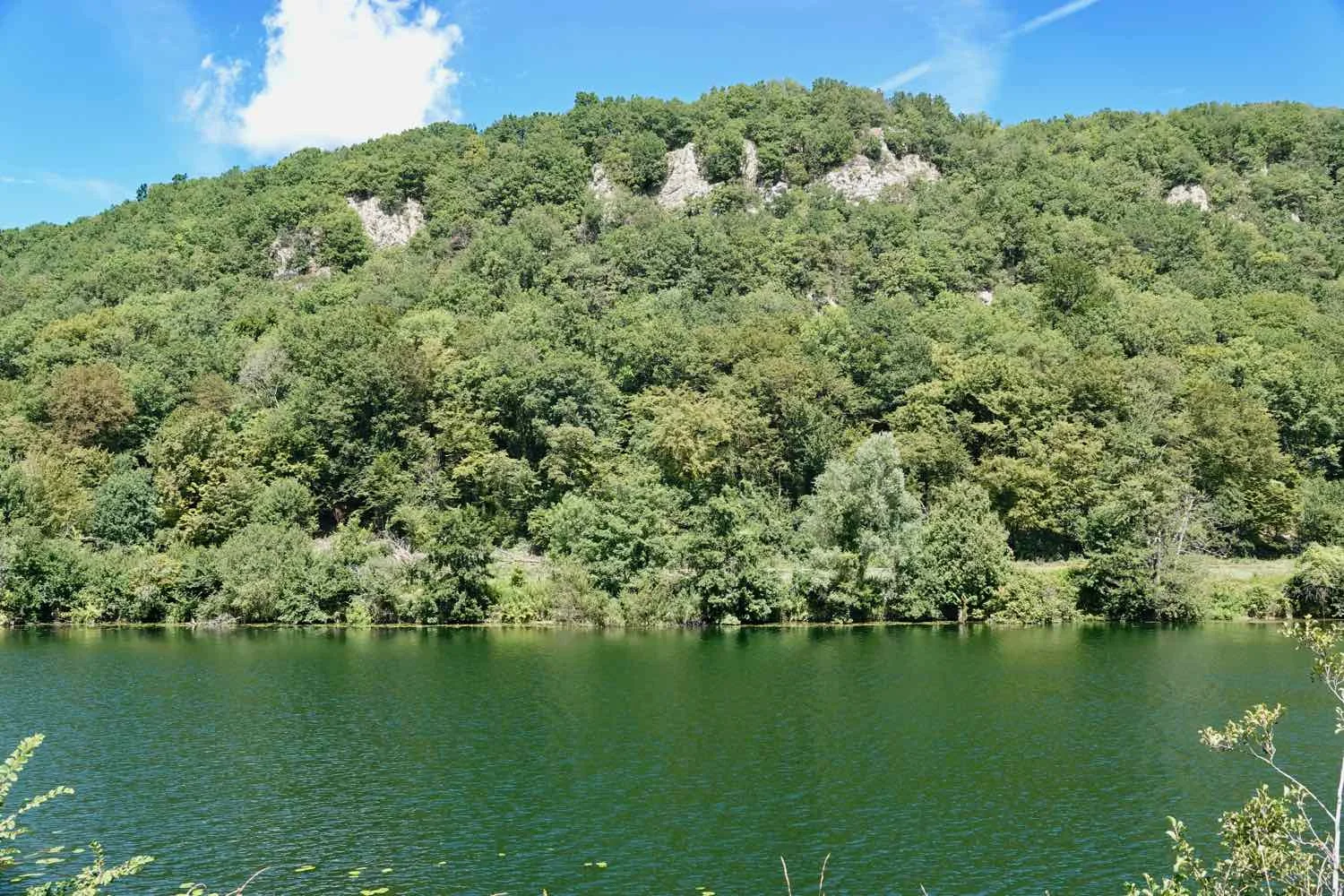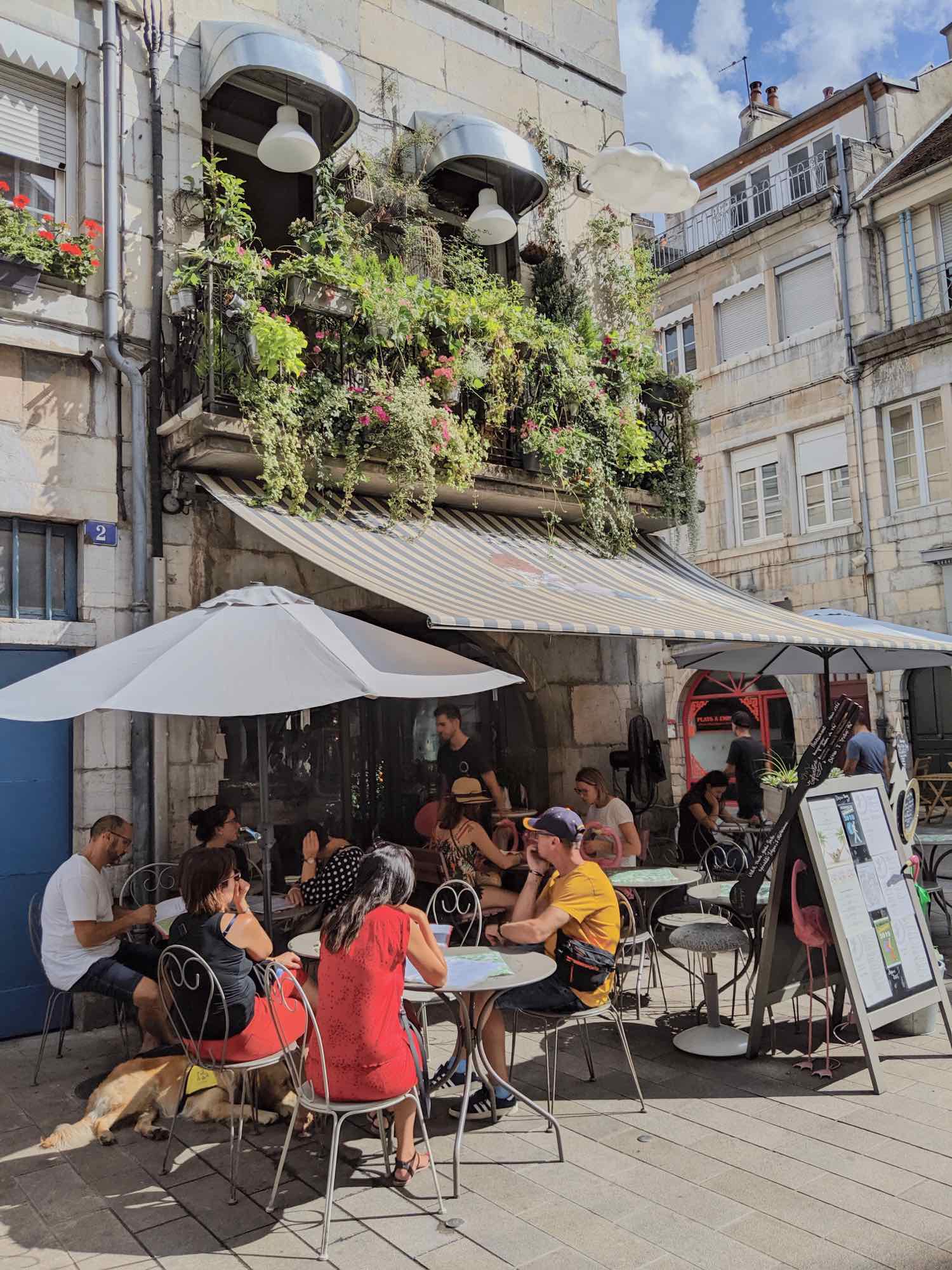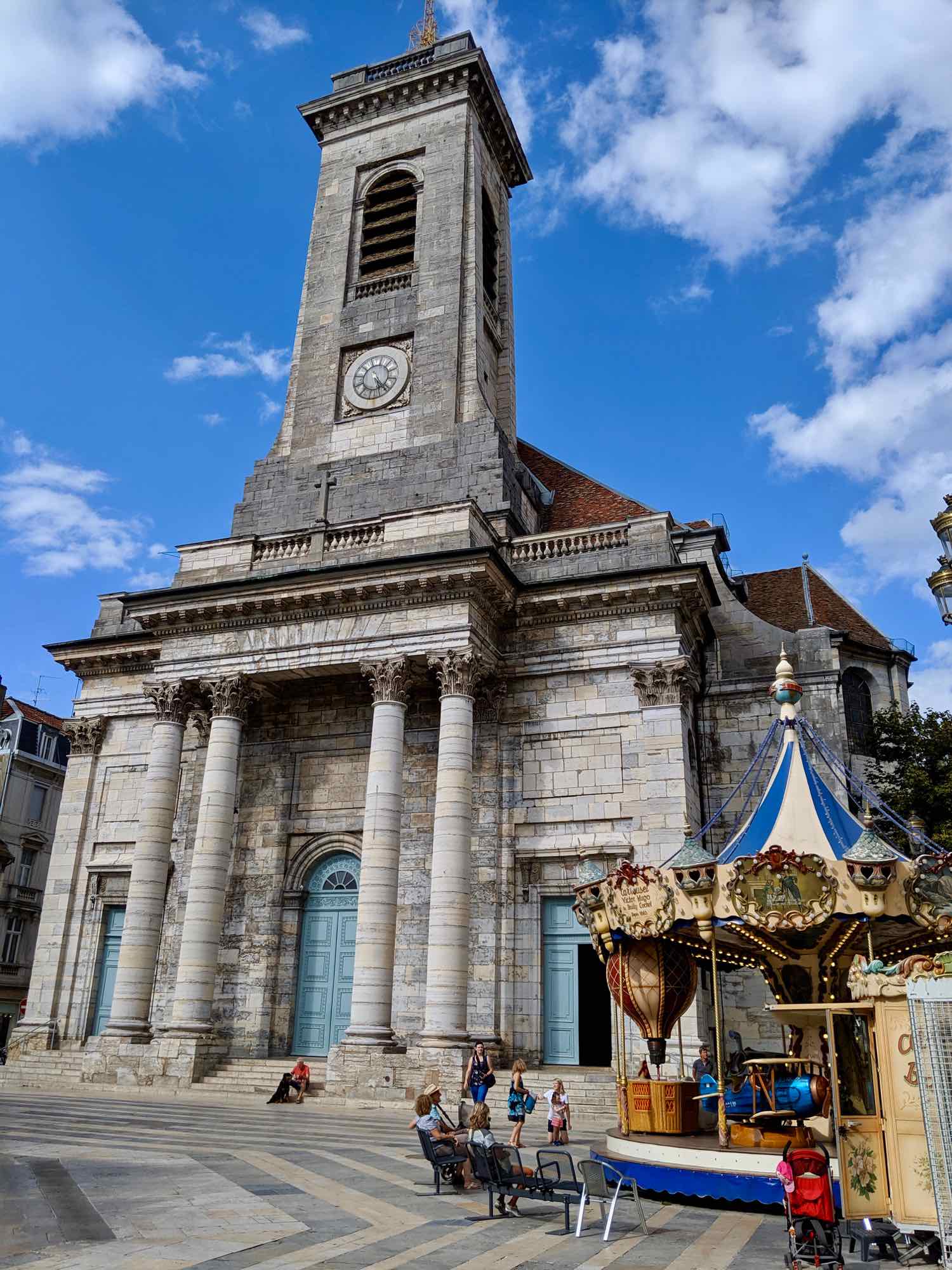Cycling Dole to Besançon, France: Rugged Cliffs and Cobblestones
10-11 August 2019
Dole to Besançon (10 August 2019, 64.4 km, 40 mi)
We cycled for most of the day along either the Rhône-to-Rhine Canal or the Doubs River. From the early 1800s, the canal was a critical transportation corridor because it linked the North Sea (via the Rhine) to the Mediterranean (via the Rhône). The Doubs River parallels the canal, and sometimes joins with it.
The tranquil Rhône-to-Rhine Canal, our constant companion through western France. Lavans-lès-Dole, France. Copyright © 2018-2019 Pedals and Puffins.
We continued our habit of getting breakfast at a bakery along the way. This time we detoured into the village of Orchamps. One sure sign that there is food around is the presence of other touring cyclists. We saw several bikers heading out of Orchamps, and guessed that there must be food up on the hill where they’d come from. We were right. And while we were eating our quiches and pastries in the town park, several other cyclists stopped at the bakery. Given that the locals seem to mostly buy 59¢ baguettes, we suspect touring cyclists are an important source of income for these bakeries. We always buy the more expensive, high-calorie options.
We’re part of an exclusive club. There are some places only bikes can go. Saint-Vit, France. Copyright © 2018-2019 Pedals and Puffins.
When we reached the town of Thoraise, we were impressed to see that the canal runs through a tunnel. That’s right, the canal goes right through a big, stone outcrop, cutting off an oxbow bend in the river. Peering inside, we could see twinkling strings of lights, making it look downright festive. This tunnel is “only” 185 m long (607 ft), so we could see daylight coming through from the other side. Unfortunately, there weren’t any canal boats going through the tunnel when we passed by. That would have been fun to see.
The canal tunnel at Thoraise, France. Copyright © 2018-2019 Pedals and Puffins.
This boat was moored to the side of the canal, and didn’t look like it would be going through the tunnel any time soon. Thoraise, France. Copyright © 2018-2019 Pedals and Puffins.
The tunnel exists because throughout this area, the canal cuts through the Jura Mountains of France. It is bordered by cliffs on the north and high hills to the south. The cliffs are mostly covered with a thick forest, but also have lots of rocky outcrops. We saw evidence of mining in the hills, with some old, stone towers on the ridges, and triangular swaths of mine tailings scattered on the slopes.
Ruined stone towers on the cliffs along the Rhône-to-Rhine canal could be old castles, or just the remains of old mines. France. Copyright © 2018-2019 Pedals and Puffins.
As we head deeper into August, the late summer wildflowers are putting on a grand show. Wherever there are open fields, the flowers are taking over. We see a lot of familiar roadside species, like Queen-Anne’s-lace, knapweed and chicory. France. Copyright © 2018-2019 Pedals and Puffins.
In western France, we’re starting to see some German and Swiss influences in the architecture. Some of the church steeples in this region are silver-plated. Copyright © 2018-2019 Pedals and Puffins.
Today we played “leap frog” along the route with a biker from Germany. We would pass him when he stopped for a rest break, and vice versa - waving as we passed by. Then, just as we were arriving in Besançon, he caught up with us and we had a chance to chat. He was cycling back to his home town near Heidelberg, Germany. We learned that he had done a lot of bicycle touring over the years, including a trip through West Africa that started in Germany, crossed over the mouth of the Mediterranean at Gibraltar to Morocco, and ended in Sierra Leone. He’s also biked from Patagonia in Chile, up to Bolivia. Pretty major trips. We enjoyed hearing about his travels, and imagining what those trips must have been like.
Cycling into Besançon has a pretty high, “wow” factor. Ahead of us, way up on a cliff, were the impressive stone walls of the city’s huge citadel.
We’ve seen a lot of old towers dotting the cliff tops, but nothing like this. The citadel looming over Besançon stands out for its sheer size, and the way it seems to just grow out of the rocks. France. Copyright © 2018-2019 Pedals and Puffins.
The main route for EuroVelo 6 avoids going into Besançon, which is a pity. It’s a beautiful city. We followed the big bend in the Doubs River as it swung to the north around the old part of town. Along the way we passed the old city walls, and had lovely views of the waterfront quays that line the river.
The path got a little bumpy, when we hit the section that was all cobblestones. Walking our bikes allowed us to enjoy the waterfront views without the bone-rattling effects of riding on the stones. Besançon, France. Copyright © 2018-2019 Pedals and Puffins.
Besançon looks like a vey intriguing town. When we walked to the supermarket to pick up some dinner, we both got the feeling that the city has a lot of character. When you walk by streets and alleyways, they look like they lead to interesting places.
Besançon Rest Day (11 August 2019)
We were all packed up and ready to head out on the road this morning, when we stopped to think about whether it made more sense to stay another day in Besançon. On the negative side, the internet in our room was terrible, and we would be unable to use it for anything. On the plus side, we both thought it would be entertaining to visit the citadel that towers over the town. An extra nudge towards staying in town was that the weather forecast called for another rainy night. We planned to camp after leaving here. So spending another rainy night in the hotel - rather than in a tent - was very appealing. We decided to stay.
Mid-morning, we walked up to the citadel. It’s perched on a rocky outcrop that overlooks the city. Besançon is enclosed within a large, horseshoe-shaped bend in the Doubs River. And the citadel sits more than 100 m above the city on a cliff that closes off the open end of the horseshoe. So to get there, you have to hike uphill.
View of Besançon, France, from the gates of the citadel. Copyright © 2018-2019 Pedals and Puffins.
The citadel was built under the direction of one of France’s most famous military engineers, the Marquis de Vauban. He served under Louis XIV, and had far-reaching influence on both military infrastructure and offensive tactics. You can’t escape his presence when visiting the citadel, which is considered one of his crowning achievements. Information about him and his role in the construction of the fortress is everywhere. Apparently, the building of the citadel was so innovative - and expensive - that Louis VIX once asked Vauban whether the walls had been made of gold.
The Marquis de Vauban, planning some impressive new military structure. Besançon, France. Copyright © 2018-2019 Pedals and Puffins.
Something that makes the citadel unique among all of the other forts we’ve visited is that it houses a small zoo. Along the main, outer wall, lives a troop of Gelada monkeys from Ethiopia. They have a lot of room to roam, including the ability to climb down into the ditch of the citadel’s old moat. We couldn’t get very close to them, but it was entertaining to observe them from a distance. An animal keeper came out to feed the monkeys, which got them all riled up. We watched as they postured and taunted each other to try and steal food, including one hot pursuit that led down into the moat.
We walked around the citadel’s outer walls, soaking up the view. It was interesting to see the lay of the land. We caught sight of the bicycle path that we used to we enter the city, and the one we would use to leave town tomorrow..
Tomorrow we’ll be heading out of town on the bike path that hugs the right-hand side of the river. Besançon, France. Copyright © 2018-2019 Pedals and Puffins.
View of the citadel’s interior buildings. Besançon, France. Copyright © 2018-2019 Pedals and Puffins.
Without a source of water, the citadel was vulnerable to a siege. So Vauban had a well dug to a depth of 132 m (433 ft). This wheel was supposed to be used to raise water from the well by having a man walk inside it, like a hamster on a running wheel. Unfortunately, the water from the well was brackish and undrinkable. So the citadel ended up relying on cisterns, instead. Besançon, France. Copyright © 2018-2019 Pedals and Puffins.
Besides the Gelada monkeys on the outer wall, there are also lots of other animals on display within the citadel.
Bike path we rode into the city, on the left-hand side of the Doubs River. Besançon, France. Copyright © 2018-2019 Pedals and Puffins.
In one of the museums within the citadel, we learned about the use of decorative fireplace plates in this part of France. The big, iron plates allowed heat from a fire to penetrate into another room at the back of the fireplace. Over time, they became important objects of art as well as function. Besançon, France. Copyright © 2018-2019 Pedals and Puffins.












